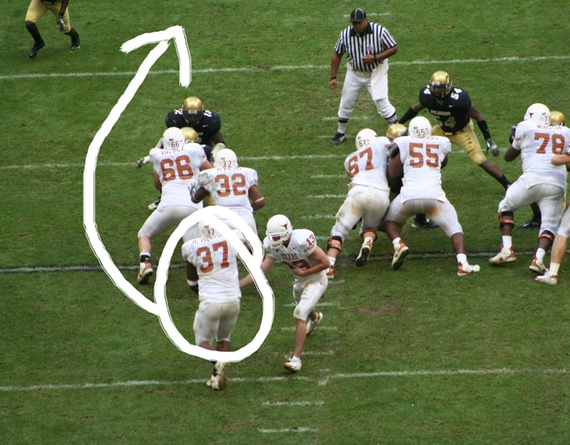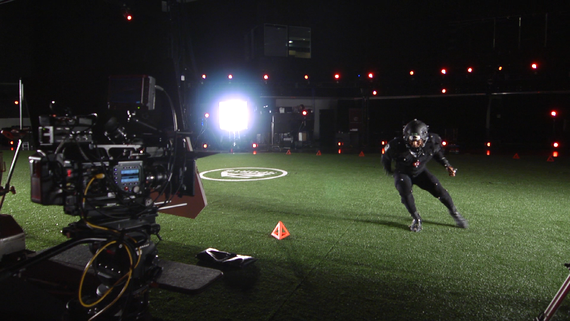It is impossible to consider American football without considering television.
It’s not just hammy touchdown celebrations or contractually-obligated media comments. The form of football fits TV. It takes place on a big, wide-screen field. It pauses frequently for time-outs or to reset the chain—perfect opportunities for commercial breaks. And unlike baseball, radio’s sport, there’s not a single through-line that can be described by an announcer.
Televised football is such a big business, too, that all these changes go super-fractal: The game is already ad-friendly, so networks insert even more ads.
But television isn’t the only medium shaping the sport. It’s increasingly impossible to consider American football without considering video games, too.
I recently talked to two people who are helping bring about that shift: Madden NFL 15’s creative director, Mike Young, and its presentation director, Brian Murray. I asked them what techniques and camera angles they saw first in the Madden games and that they now see on TV.
Before launching in, it’s worth nothing that their backgrounds span the console and the camera. Young came up through EA Sports, working on its NBA Street franchise for more than a decade before switching to Madden. Murray’s background is a little more television-focused: He was a senior cinematographer with NFL Films, and a director of photography for ESPN’s 30 for 30 series, before being recruited by Young.
The first thing about where the networks have borrowed from video games is: No one is sure. “A lot of it is speculation—it’s hard to have confirmed copying going on,” Young told me at one point.
But Young, Murray, and others told me about quickly enumerated a number of features that first appeared in Madden and are now major facets of televised football production. The first of those?
1. The cable-cam
From its first entry, the cable-cam’s similarity to the video game view has been highlighted. A 2008 Ars Technica article noted:
While cameras have been omnipresent at NFL games for decades, the ‘flying’ overhead camera is a recent twist that enables broadcasters to provide views directly from behind the quarterback or from the middle of the defense—a view long-familiar to fans of EA’s Madden and NCAA Football franchises.
The sweeping pans, the ability to follow play down the field from just-above-and-behind, reminds the viewer of what it’s like to play a video game. The cable-cam was introduced by most TV networks in the late 2000s. Murray and Young estimated that Madden players had seen the view or something like it since the game first went three-dimensional in the late 1990s.
2. Icons beneath the players

While most viewers have long been used to different ways of calling out individual players and directions on the field—telestrator, anyone?—broadcasts have recently turned to putting concentric circles or icons beneath players to highlight them. It seems to borrow from a certain video-game convention: Drawing concentric circles beneath athletes’s feet to convey you are controlling this character.
Murray and Young weren’t sure how long Madden had been calling out players with icons beneath their feet, but they thought it went back a long time. Such a technique also isn’t limited to Madden alone: I know I’ve played role-playing fantasy games where control was indicated with sub-podal icons.
Both men added to that player icons are just one facet of how players are highlighted now. For a couple years, they said, Madden has been attaching graphics “on-screen” to players as they move around the field. In replays during half-time shows, or just after commercial breaks, they said, they’re beginning to see broadcasts do something similar.

(One place where TV beat Madden? The yellow line that indicates where teams get a new set of downs. Young said that major networks had the yellow line about two years before the Madden games did.)
4. The directorial style?

But beyond new camera angles or graphics techniques, both men said they wondered if their directorial style was leaking into broadcasts. For this year’s game, Young said, he chose to draw techniques and styles from NFL Films.
Working with Murray, he filmed a cinematographer that could be added to the games. The Madden games, by one mode of accounting, have two layers: A play layer, where the actual game occurs; and a production layer, where the format and presentation of the game is shown to the player. It’s important that if a cameraman is shooting an angle shown to the player in one second, then, in the next shot, the same cameraman appear (if he would be in the frame).
“There’s a whole layer of logic to account for certain situations—like third-and-one in a tie-game—about how to shoot that, how to pay it off,” said Young.
And because they’re unconstrained by actual in-game risks, Murray and Young let those simulated camera-operators and directors take more risks than they would in a broadcast.
“We’re trying to look at the future, at what they’d want to do,” said Murray.
In Madden 15, for instance, a Steadicam operator will often follow a quarterback as he stops talking to the coach, walks on to the field, and enters a huddle. Only as he begins to take his place on the field will the cameraman finally back off.
That was supposed to be something that could only appear in the game. But now, both men have seen Steadicam operators do the same thing on TV.
“I’m not saying there’s any confirmation they did it, but I did it with Mike and now I’m seeing it in the broadcast,” said Murray.
In particular, Murray said, he wonders if CBS is borrowing certain elements of Madden in its broadcast. (I reached out to CBS representatives about how their game producers thought live, televised football related to video games, but did not hear back before publication.)
Both men also said live game producers and directors are jealous of their creative freedom. “We’ll meet with the producer and director for Monday Night Football and they’ll ask us what we do. There’s some jealousy with our freedom to put a camera anywhere and do it cheaply,” Young said.
Talking to Young and Murray, I thought back to another funny episode in sports. After an amazing game last week, Miami Heat center Hassan Whiteside said he hoped there’d be one big outcome of his performance. “I’m just trying to really get my NBA 2K rating up,” he said. NBA 2k is a console game that updates its players stats through the season, reflecting the changing state and talents of the professional league.
Young and Murray are trying both to mimic televised football. Whiteside is playing great in the actual NBA—the real thing!—but what he really wants is for his digital facsimile to get better. This is like Robin Sloan’s idea of the flip-flop—where a physical thing becomes digital before going physical again—but at the level of huge corporations, hundred-million-person broadcasts, and individual athlete desires.
And maybe it gets at what feels more real to the players, the directors, and everyone involved in professional sports. If you’re an athlete—or a TV live-game director—you both know what the NFL looks like on the screen and from behind the proverbial curtain. Maybe playing the video game, where special effects and plays retain their luster, feels more like real life. And maybe that’s why, over time, you begin to emulate its style. And it's worth noting, too, that today's professional athletes are young enough that they themselves grew up playing Madden and similar games.
Or maybe that’s just how you go after fans, keep them interested. After all, most viewers have never coached an NFL team or played on the field. But they’ve probably played a lot of Madden.
This article was originally published at http://www.theatlantic.com/technology/archive/2015/01/televised-football-is-looking-more-like-a-video-gamein-subtle-ways/385057/



















